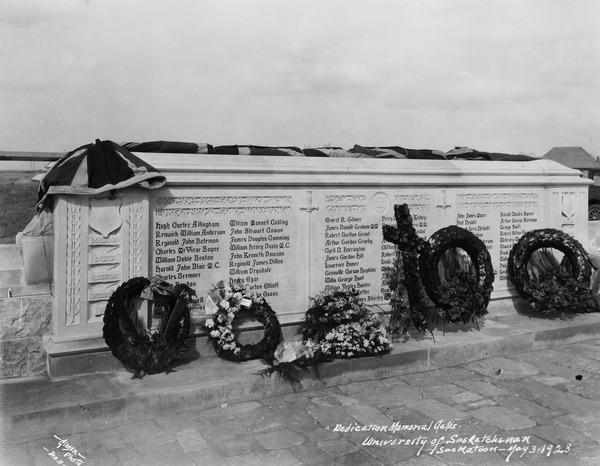Search Great War Images from the U of S
Campus Memorials
 As early as March 1916, the University of Saskatchewan Board of Governors decided to create a Roll of Honour by having “the names of all students, and others connected with the University who have enlisted, painted on the ‘ribbons’ in the corridors” of the College Building. These ribbons were part of the original building design. Names of 349 veterans have been inscribed on the walls, including some that were added following research over 85 years later. About three-quarters of these veterans were University of Saskatchewan students when they enlisted; the others were graduates, former students, faculty, and staff. Names of the volunteer nurses who treated patients during the 1918 influenza epidemic are also inscribed on the walls. Veterans who came to the University of Saskatchewan only after the war, however, are generally not included.
As early as March 1916, the University of Saskatchewan Board of Governors decided to create a Roll of Honour by having “the names of all students, and others connected with the University who have enlisted, painted on the ‘ribbons’ in the corridors” of the College Building. These ribbons were part of the original building design. Names of 349 veterans have been inscribed on the walls, including some that were added following research over 85 years later. About three-quarters of these veterans were University of Saskatchewan students when they enlisted; the others were graduates, former students, faculty, and staff. Names of the volunteer nurses who treated patients during the 1918 influenza epidemic are also inscribed on the walls. Veterans who came to the University of Saskatchewan only after the war, however, are generally not included.
The Memorial Gates, while no longer marking the entrance to the University of Saskatchewan, remain the University's memorial to the 69 students and faculty who perished in the Great War. Designed by the original University architect, David R. Brown of Montreal, the memorial consists of two main gates, on either side, (originally*) for vehicular traffic and two small gates for pedestrians. The gates themselves are of solid bronze imported from England, the balance being of local greystone. A stone tablet, positioned between the bronze gates, bears the inscription: "These are they who went forth from this University to the Great war and gave their lives that we might live in freedom." Erected in 1927-28 at a cost of thirty thousand dollars, the gates and tablet were unveiled by President W.C. Murray and the memorial dedicated by the Bishop of Saskatchewan on 3 May, 1928. From November of that year to the present time, Remembrance Day services have been held annually at the Gates.
A memorial stone and plaque honouring the memory of those who served with the 46th Canadian Infantry Battalion (South Saskatchewan ), Canadian Expeditionary Force, 1914-1918, rests under a tree on the northeast corner of the Bowl. "Designed by a well known sculptor of Winnipeg", it was presented to the University at a solemn ceremony in Convocation Hall on November 11, 1933.Formed in February of 1915, the 46th Canadian Infantry Battalion (South Saskatchewan ) was to have a strength of 600 men. Its ranks were filled primarily with Saskatchewan youths, many via the University of Saskatchewan. Also known as the "Suicide Battalion", it fought in some of the bloodiest encounters of the war. Reinforcements were constantly needed as battle after battle decimated its ranks. Of the 5,374 men in the 46th Battalion, 4,917 were either killed or wounded. A particularly costly battle was Passchendaele, where there were 403 casualties from the battalion's strength of 600 men. With the end of the war came demobilization and the end of 46th Battalion. The soldiers became veterans and returned to civilian life. Many re-enrolled or entered the university for the first time. Many others did not return. Among those honoured on the plaque are Harold Blair and Reginald Batemen, two members of faculty killed in France.
The Great War exacted a heavy toll on the U of S. Of the 345 students, faculty and staff who enlisted, 69 "passed out of the sight of man by the path of duty and self-sacrifice". More than 100 more were wounded and 33 were awarded medals of valour. The School of Engineering closed its doors for the 1916-1917 session when the faculty and students enlisted en masse.

